Corporate Communication Report: MNG81001, Southern Cross University
VerifiedAdded on 2023/01/20
|32
|7835
|34
Report
AI Summary
This comprehensive report, prepared by a group of students for the MNG81001 Management Communication unit at Southern Cross University, explores the multifaceted aspects of corporate communication. The report delves into critical areas such as identity, image, and reputation management, examining how these elements are interconnected and vital for organizational success. It further investigates corporate social responsibility, emphasizing the importance of ethical, social, and environmental considerations in business communication. The analysis extends to media relations, covering both traditional and social media strategies, and concludes with a focus on crisis management, offering insights into effective communication before, during, and after a crisis. The report provides a detailed overview of these key areas, offering practical recommendations for managers seeking to master the corporate communication function and build a strong, sustainable organizational presence.
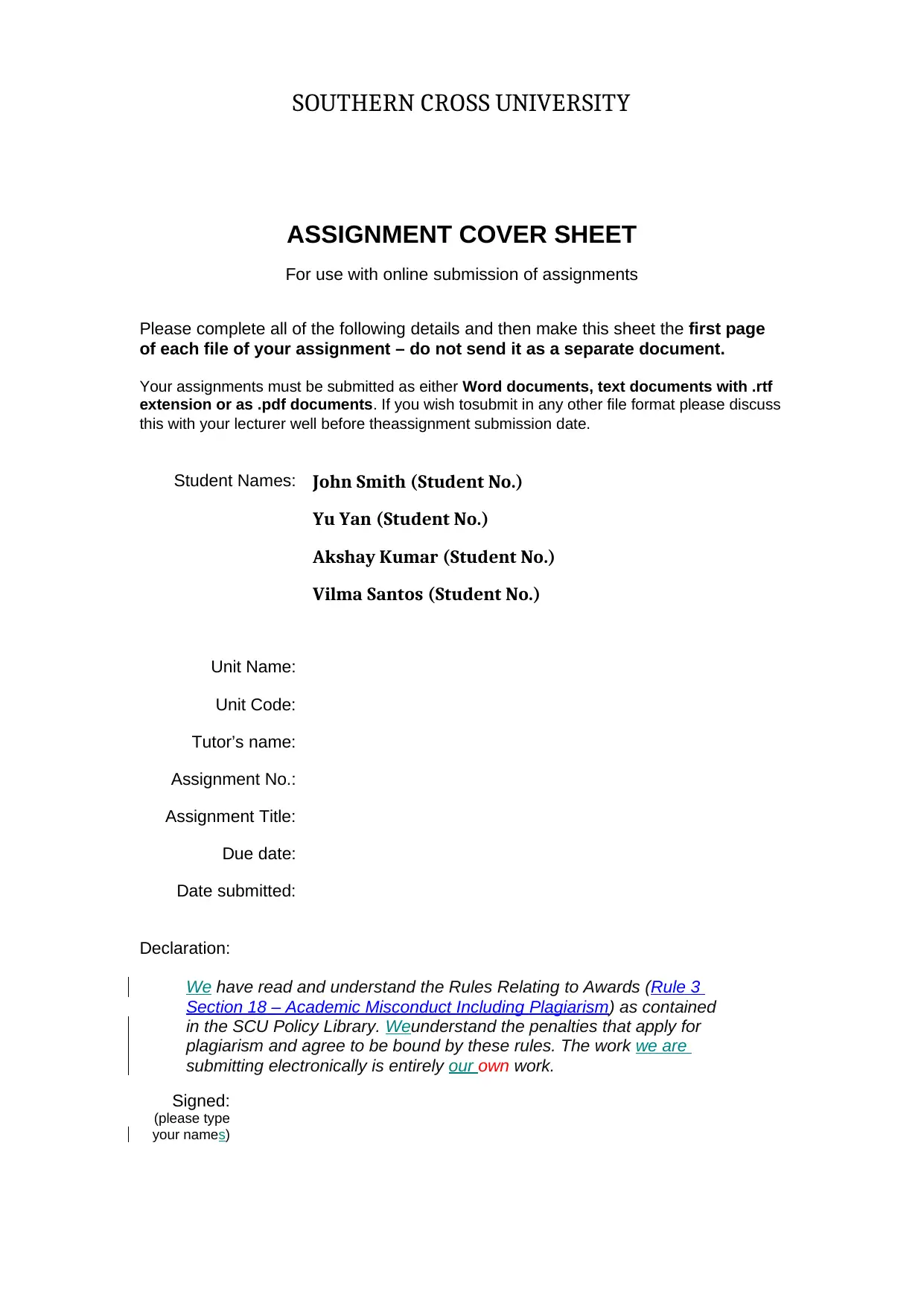
SOUTHERN CROSS UNIVERSITY
ASSIGNMENT COVER SHEET
For use with online submission of assignments
Please complete all of the following details and then make this sheet the first page
of each file of your assignment – do not send it as a separate document.
Your assignments must be submitted as either Word documents, text documents with .rtf
extension or as .pdf documents. If you wish tosubmit in any other file format please discuss
this with your lecturer well before theassignment submission date.
Student Names: John Smith (Student No.)
Yu Yan (Student No.)
Akshay Kumar (Student No.)
Vilma Santos (Student No.)
Unit Name:
Unit Code:
Tutor’s name:
Assignment No.:
Assignment Title:
Due date:
Date submitted:
Declaration:
We have read and understand the Rules Relating to Awards (Rule 3
Section 18 – Academic Misconduct Including Plagiarism) as contained
in the SCU Policy Library. Weunderstand the penalties that apply for
plagiarism and agree to be bound by these rules. The work we are
submitting electronically is entirely our own work.
Signed:
(please type
your names)
ASSIGNMENT COVER SHEET
For use with online submission of assignments
Please complete all of the following details and then make this sheet the first page
of each file of your assignment – do not send it as a separate document.
Your assignments must be submitted as either Word documents, text documents with .rtf
extension or as .pdf documents. If you wish tosubmit in any other file format please discuss
this with your lecturer well before theassignment submission date.
Student Names: John Smith (Student No.)
Yu Yan (Student No.)
Akshay Kumar (Student No.)
Vilma Santos (Student No.)
Unit Name:
Unit Code:
Tutor’s name:
Assignment No.:
Assignment Title:
Due date:
Date submitted:
Declaration:
We have read and understand the Rules Relating to Awards (Rule 3
Section 18 – Academic Misconduct Including Plagiarism) as contained
in the SCU Policy Library. Weunderstand the penalties that apply for
plagiarism and agree to be bound by these rules. The work we are
submitting electronically is entirely our own work.
Signed:
(please type
your names)
Paraphrase This Document
Need a fresh take? Get an instant paraphrase of this document with our AI Paraphraser

Date:
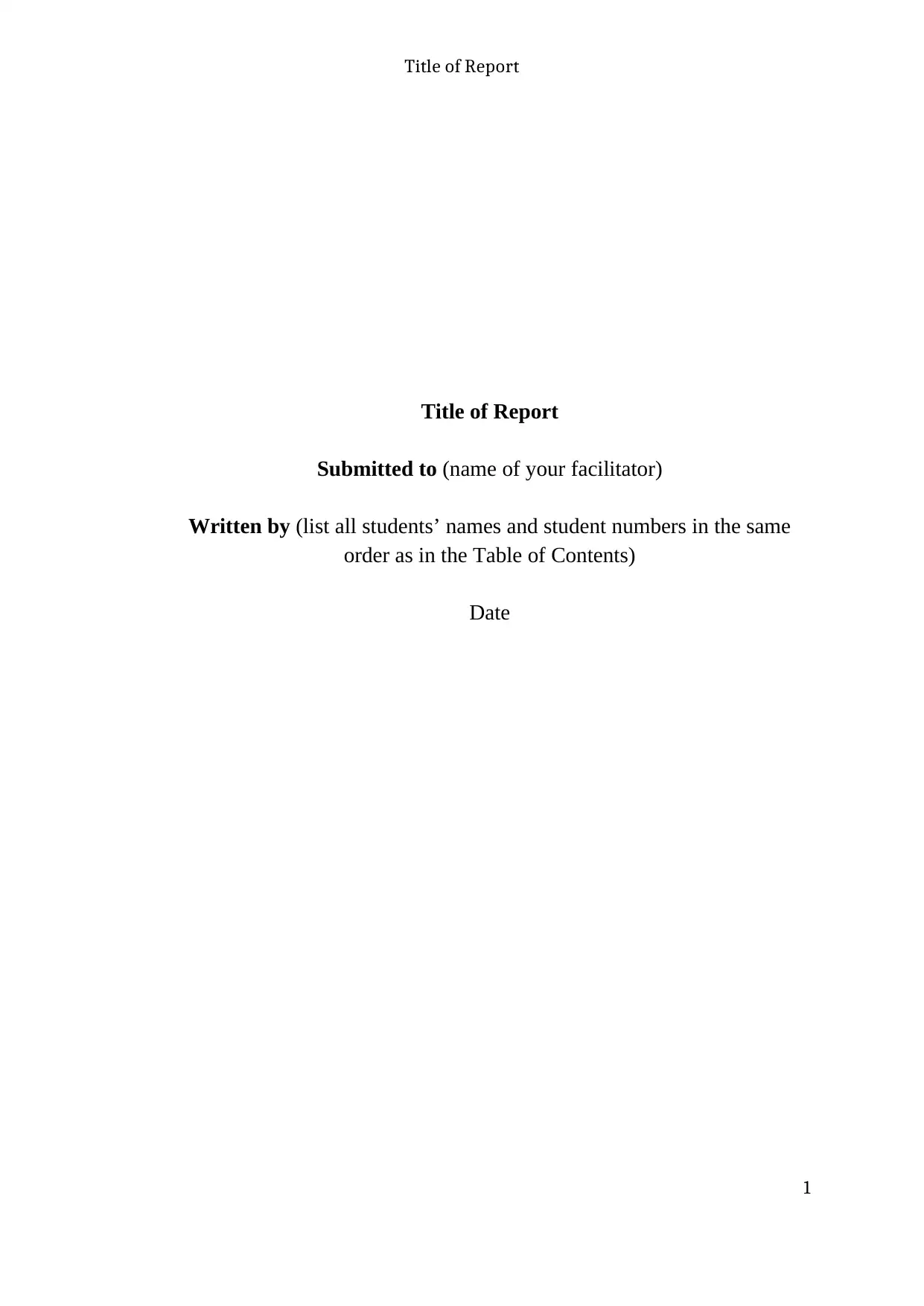
Title of Report
Title of Report
Submitted to (name of your facilitator)
Written by (list all students’ names and student numbers in the same
order as in the Table of Contents)
Date
1
Title of Report
Submitted to (name of your facilitator)
Written by (list all students’ names and student numbers in the same
order as in the Table of Contents)
Date
1
⊘ This is a preview!⊘
Do you want full access?
Subscribe today to unlock all pages.

Trusted by 1+ million students worldwide
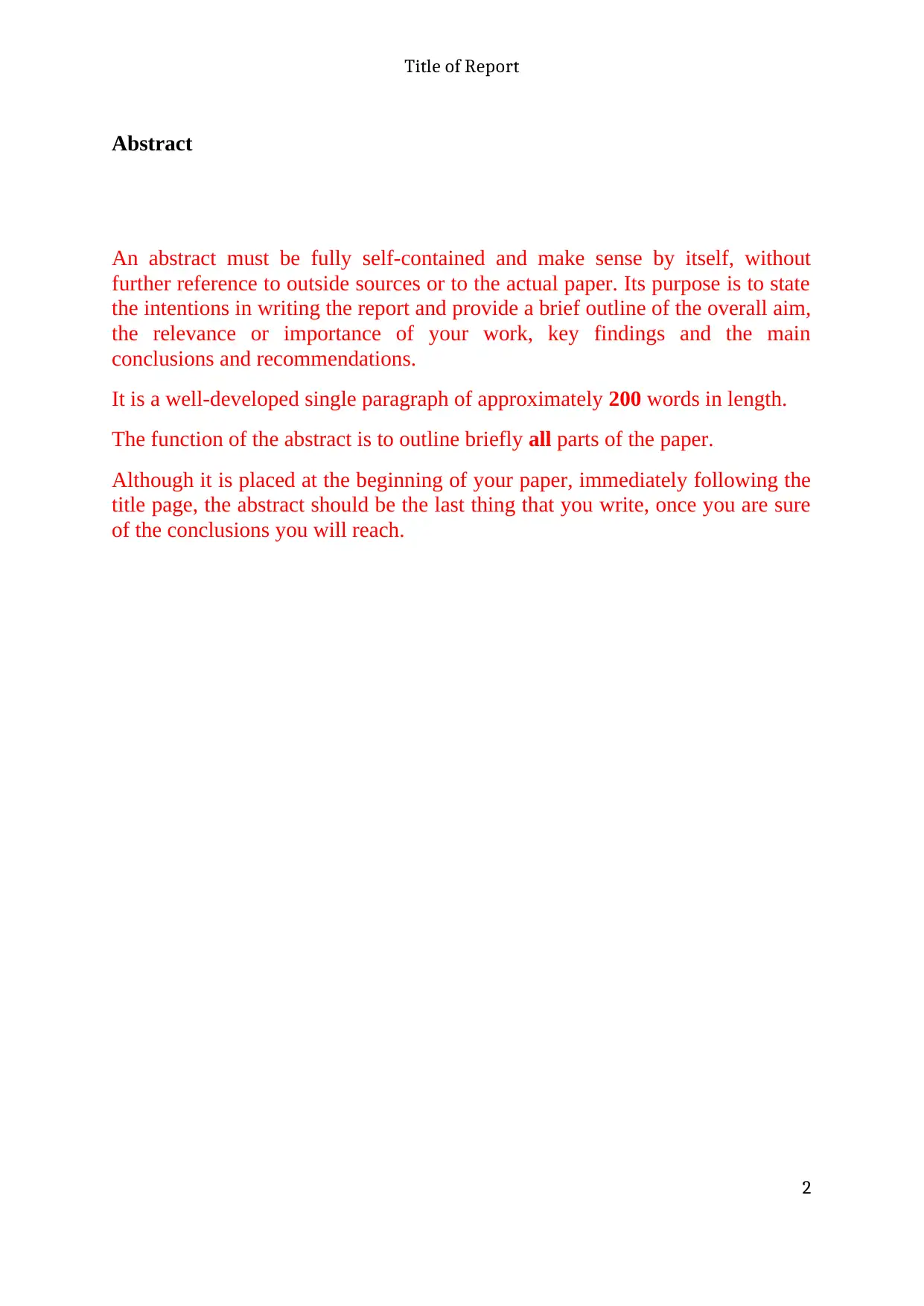
Title of Report
Abstract
An abstract must be fully self-contained and make sense by itself, without
further reference to outside sources or to the actual paper. Its purpose is to state
the intentions in writing the report and provide a brief outline of the overall aim,
the relevance or importance of your work, key findings and the main
conclusions and recommendations.
It is a well-developed single paragraph of approximately 200 words in length.
The function of the abstract is to outline briefly all parts of the paper.
Although it is placed at the beginning of your paper, immediately following the
title page, the abstract should be the last thing that you write, once you are sure
of the conclusions you will reach.
2
Abstract
An abstract must be fully self-contained and make sense by itself, without
further reference to outside sources or to the actual paper. Its purpose is to state
the intentions in writing the report and provide a brief outline of the overall aim,
the relevance or importance of your work, key findings and the main
conclusions and recommendations.
It is a well-developed single paragraph of approximately 200 words in length.
The function of the abstract is to outline briefly all parts of the paper.
Although it is placed at the beginning of your paper, immediately following the
title page, the abstract should be the last thing that you write, once you are sure
of the conclusions you will reach.
2
Paraphrase This Document
Need a fresh take? Get an instant paraphrase of this document with our AI Paraphraser
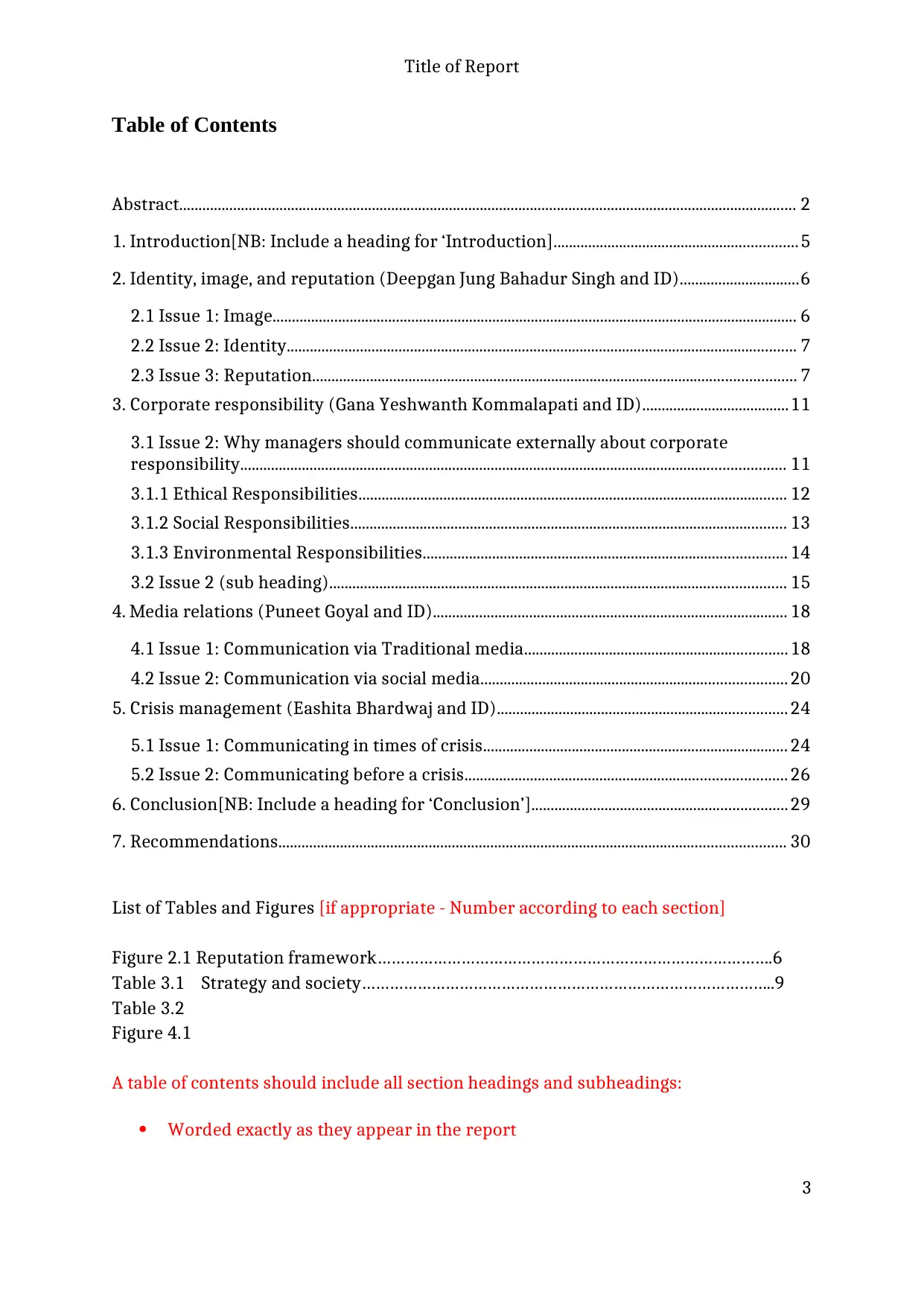
Title of Report
Table of Contents
Abstract................................................................................................................................................................ 2
1. Introduction[NB: Include a heading for ‘Introduction]...............................................................5
2. Identity, image, and reputation (Deepgan Jung Bahadur Singh and ID)...............................6
2.1 Issue 1: Image........................................................................................................................................ 6
2.2 Issue 2: Identity.................................................................................................................................... 7
2.3 Issue 3: Reputation............................................................................................................................. 7
3. Corporate responsibility (Gana Yeshwanth Kommalapati and ID)......................................11
3.1 Issue 2: Why managers should communicate externally about corporate
responsibility............................................................................................................................................. 11
3.1.1 Ethical Responsibilities............................................................................................................... 12
3.1.2 Social Responsibilities................................................................................................................. 13
3.1.3 Environmental Responsibilities.............................................................................................. 14
3.2 Issue 2 (sub heading)...................................................................................................................... 15
4. Media relations (Puneet Goyal and ID)............................................................................................ 18
4.1 Issue 1: Communication via Traditional media....................................................................18
4.2 Issue 2: Communication via social media............................................................................... 20
5. Crisis management (Eashita Bhardwaj and ID)...........................................................................24
5.1 Issue 1: Communicating in times of crisis............................................................................... 24
5.2 Issue 2: Communicating before a crisis................................................................................... 26
6. Conclusion[NB: Include a heading for ‘Conclusion’]..................................................................29
7. Recommendations................................................................................................................................... 30
List of Tables and Figures [if appropriate - Number according to each section]
Figure 2.1 Reputation framework………………………………………………………………………….6
Table 3.1 Strategy and society……………………………………………………………………………..9
Table 3.2
Figure 4.1
A table of contents should include all section headings and subheadings:
Worded exactly as they appear in the report
3
Table of Contents
Abstract................................................................................................................................................................ 2
1. Introduction[NB: Include a heading for ‘Introduction]...............................................................5
2. Identity, image, and reputation (Deepgan Jung Bahadur Singh and ID)...............................6
2.1 Issue 1: Image........................................................................................................................................ 6
2.2 Issue 2: Identity.................................................................................................................................... 7
2.3 Issue 3: Reputation............................................................................................................................. 7
3. Corporate responsibility (Gana Yeshwanth Kommalapati and ID)......................................11
3.1 Issue 2: Why managers should communicate externally about corporate
responsibility............................................................................................................................................. 11
3.1.1 Ethical Responsibilities............................................................................................................... 12
3.1.2 Social Responsibilities................................................................................................................. 13
3.1.3 Environmental Responsibilities.............................................................................................. 14
3.2 Issue 2 (sub heading)...................................................................................................................... 15
4. Media relations (Puneet Goyal and ID)............................................................................................ 18
4.1 Issue 1: Communication via Traditional media....................................................................18
4.2 Issue 2: Communication via social media............................................................................... 20
5. Crisis management (Eashita Bhardwaj and ID)...........................................................................24
5.1 Issue 1: Communicating in times of crisis............................................................................... 24
5.2 Issue 2: Communicating before a crisis................................................................................... 26
6. Conclusion[NB: Include a heading for ‘Conclusion’]..................................................................29
7. Recommendations................................................................................................................................... 30
List of Tables and Figures [if appropriate - Number according to each section]
Figure 2.1 Reputation framework………………………………………………………………………….6
Table 3.1 Strategy and society……………………………………………………………………………..9
Table 3.2
Figure 4.1
A table of contents should include all section headings and subheadings:
Worded exactly as they appear in the report
3
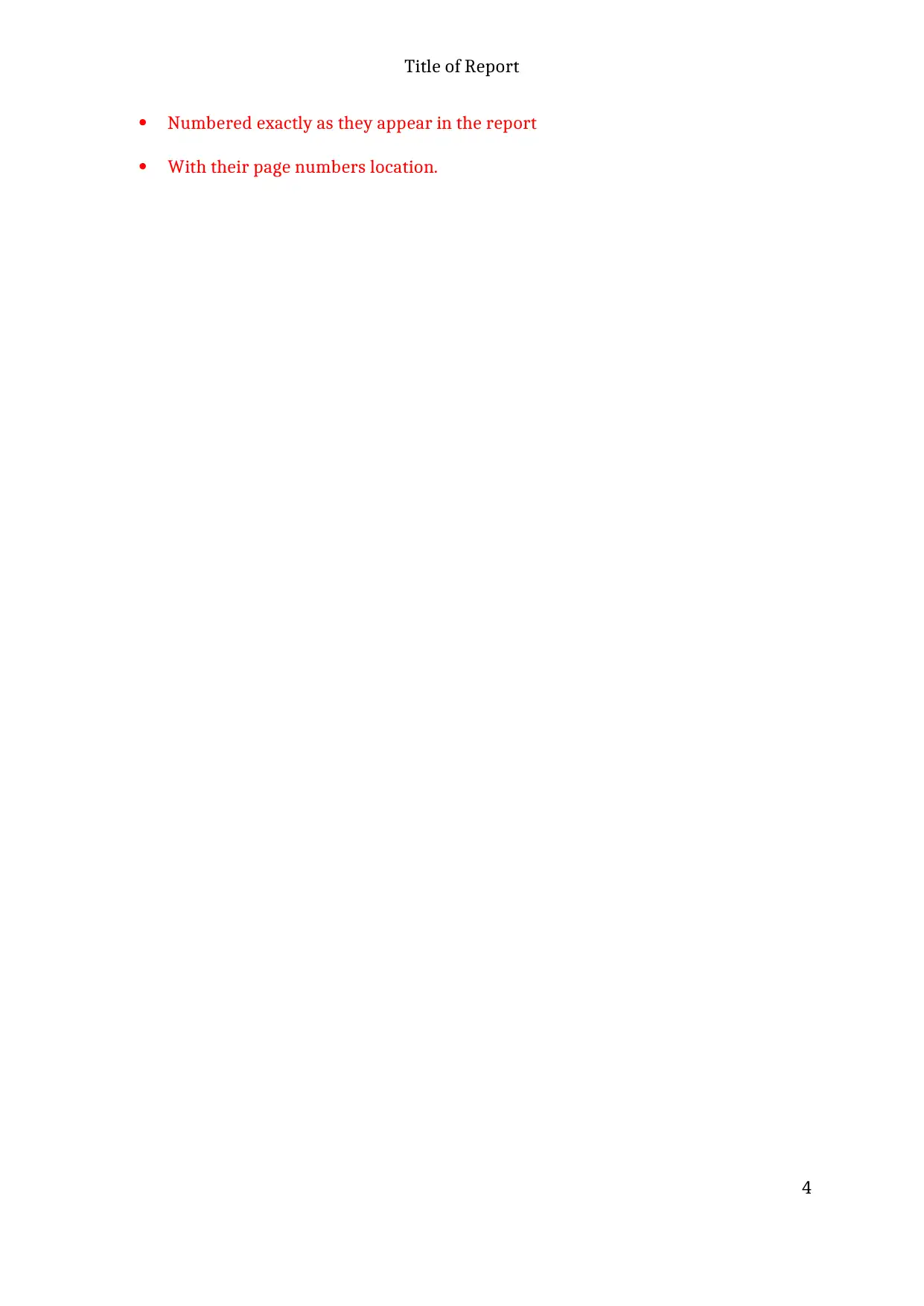
Title of Report
Numbered exactly as they appear in the report
With their page numbers location.
4
Numbered exactly as they appear in the report
With their page numbers location.
4
⊘ This is a preview!⊘
Do you want full access?
Subscribe today to unlock all pages.

Trusted by 1+ million students worldwide
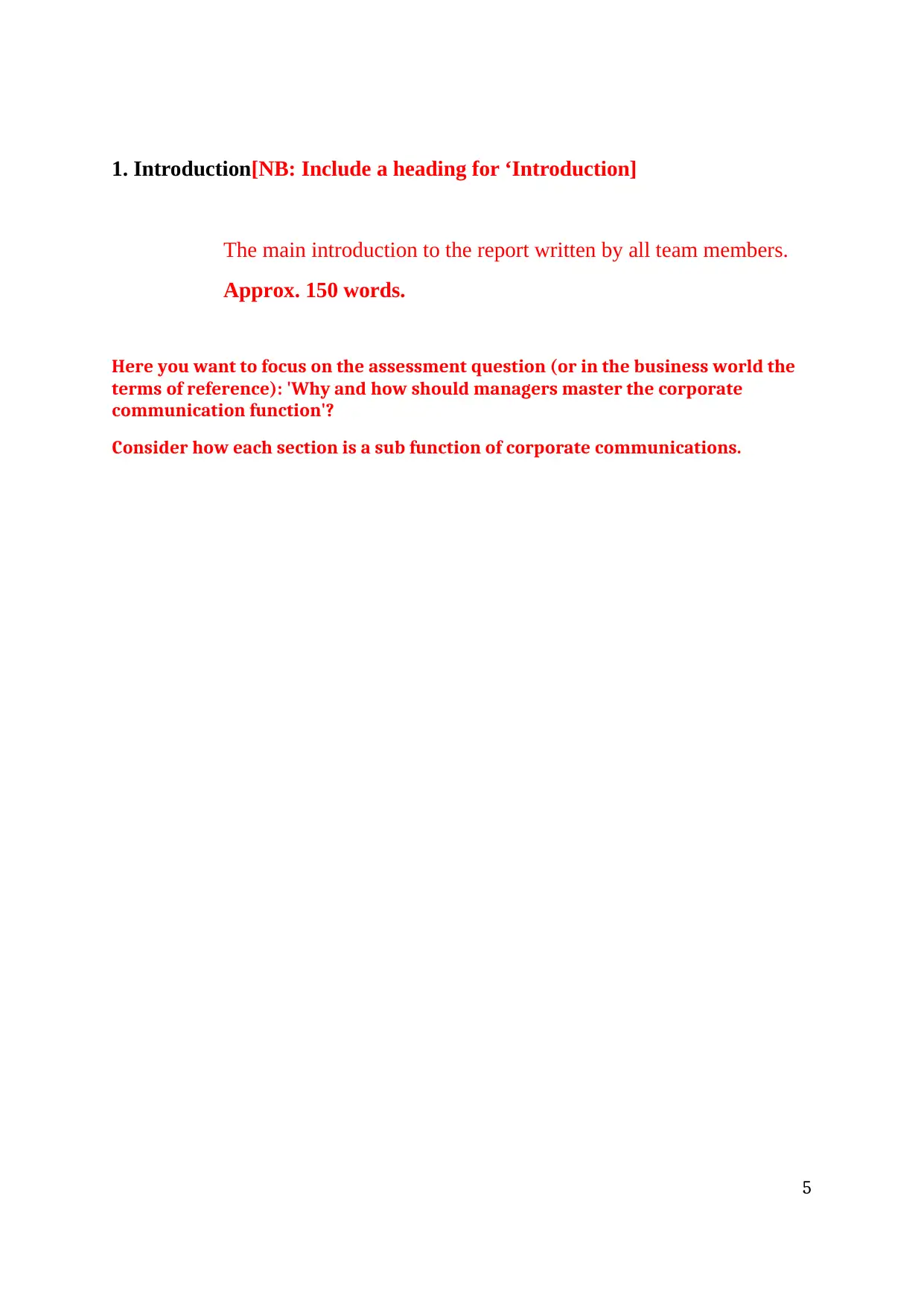
1. Introduction[NB: Include a heading for ‘Introduction]
The main introduction to the report written by all team members.
Approx. 150 words.
Here you want to focus on the assessment question (or in the business world the
terms of reference): 'Why and how should managers master the corporate
communication function'?
Consider how each section is a sub function of corporate communications.
5
The main introduction to the report written by all team members.
Approx. 150 words.
Here you want to focus on the assessment question (or in the business world the
terms of reference): 'Why and how should managers master the corporate
communication function'?
Consider how each section is a sub function of corporate communications.
5
Paraphrase This Document
Need a fresh take? Get an instant paraphrase of this document with our AI Paraphraser
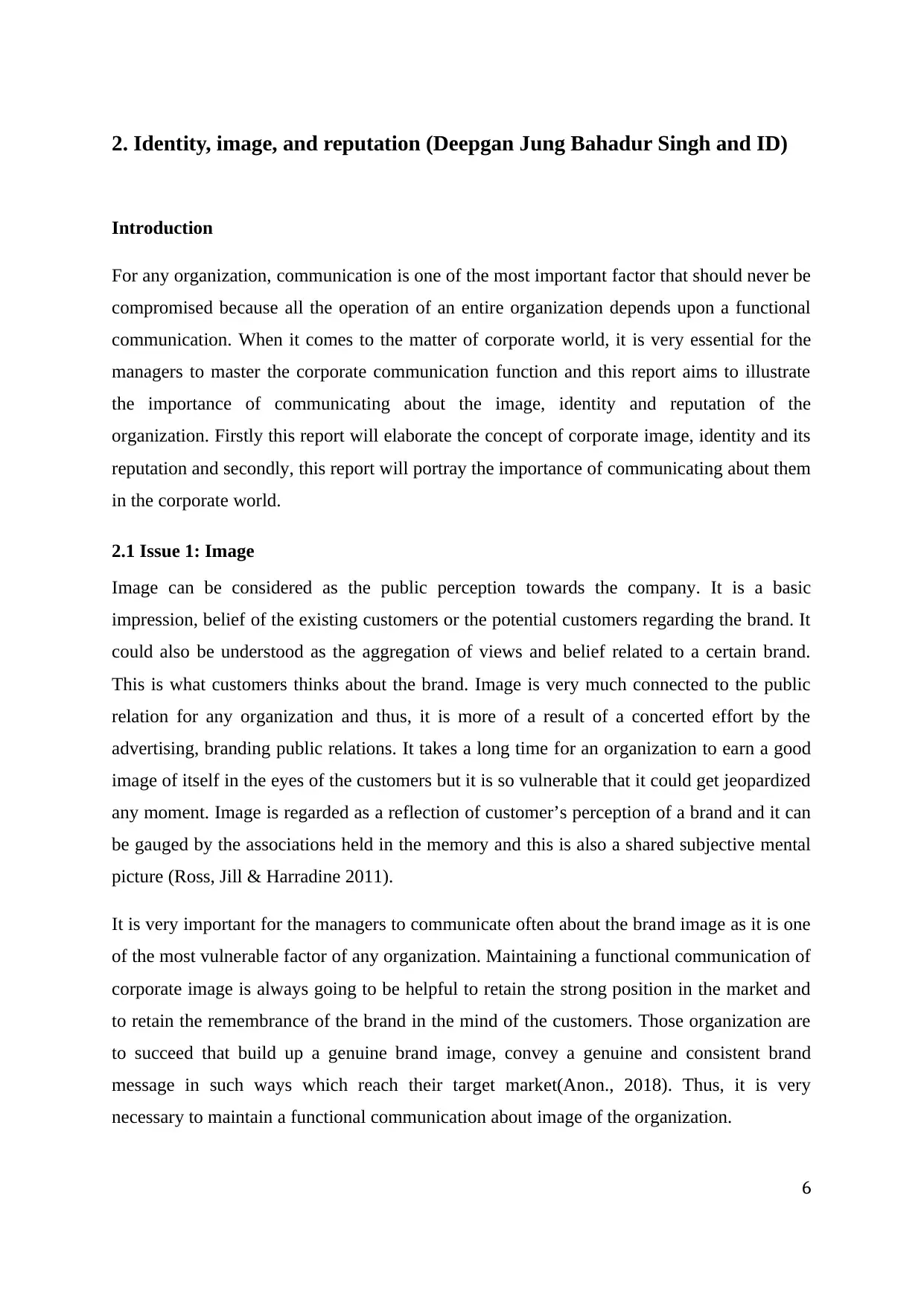
2. Identity, image, and reputation (Deepgan Jung Bahadur Singh and ID)
Introduction
For any organization, communication is one of the most important factor that should never be
compromised because all the operation of an entire organization depends upon a functional
communication. When it comes to the matter of corporate world, it is very essential for the
managers to master the corporate communication function and this report aims to illustrate
the importance of communicating about the image, identity and reputation of the
organization. Firstly this report will elaborate the concept of corporate image, identity and its
reputation and secondly, this report will portray the importance of communicating about them
in the corporate world.
2.1 Issue 1: Image
Image can be considered as the public perception towards the company. It is a basic
impression, belief of the existing customers or the potential customers regarding the brand. It
could also be understood as the aggregation of views and belief related to a certain brand.
This is what customers thinks about the brand. Image is very much connected to the public
relation for any organization and thus, it is more of a result of a concerted effort by the
advertising, branding public relations. It takes a long time for an organization to earn a good
image of itself in the eyes of the customers but it is so vulnerable that it could get jeopardized
any moment. Image is regarded as a reflection of customer’s perception of a brand and it can
be gauged by the associations held in the memory and this is also a shared subjective mental
picture (Ross, Jill & Harradine 2011).
It is very important for the managers to communicate often about the brand image as it is one
of the most vulnerable factor of any organization. Maintaining a functional communication of
corporate image is always going to be helpful to retain the strong position in the market and
to retain the remembrance of the brand in the mind of the customers. Those organization are
to succeed that build up a genuine brand image, convey a genuine and consistent brand
message in such ways which reach their target market(Anon., 2018). Thus, it is very
necessary to maintain a functional communication about image of the organization.
6
Introduction
For any organization, communication is one of the most important factor that should never be
compromised because all the operation of an entire organization depends upon a functional
communication. When it comes to the matter of corporate world, it is very essential for the
managers to master the corporate communication function and this report aims to illustrate
the importance of communicating about the image, identity and reputation of the
organization. Firstly this report will elaborate the concept of corporate image, identity and its
reputation and secondly, this report will portray the importance of communicating about them
in the corporate world.
2.1 Issue 1: Image
Image can be considered as the public perception towards the company. It is a basic
impression, belief of the existing customers or the potential customers regarding the brand. It
could also be understood as the aggregation of views and belief related to a certain brand.
This is what customers thinks about the brand. Image is very much connected to the public
relation for any organization and thus, it is more of a result of a concerted effort by the
advertising, branding public relations. It takes a long time for an organization to earn a good
image of itself in the eyes of the customers but it is so vulnerable that it could get jeopardized
any moment. Image is regarded as a reflection of customer’s perception of a brand and it can
be gauged by the associations held in the memory and this is also a shared subjective mental
picture (Ross, Jill & Harradine 2011).
It is very important for the managers to communicate often about the brand image as it is one
of the most vulnerable factor of any organization. Maintaining a functional communication of
corporate image is always going to be helpful to retain the strong position in the market and
to retain the remembrance of the brand in the mind of the customers. Those organization are
to succeed that build up a genuine brand image, convey a genuine and consistent brand
message in such ways which reach their target market(Anon., 2018). Thus, it is very
necessary to maintain a functional communication about image of the organization.
6
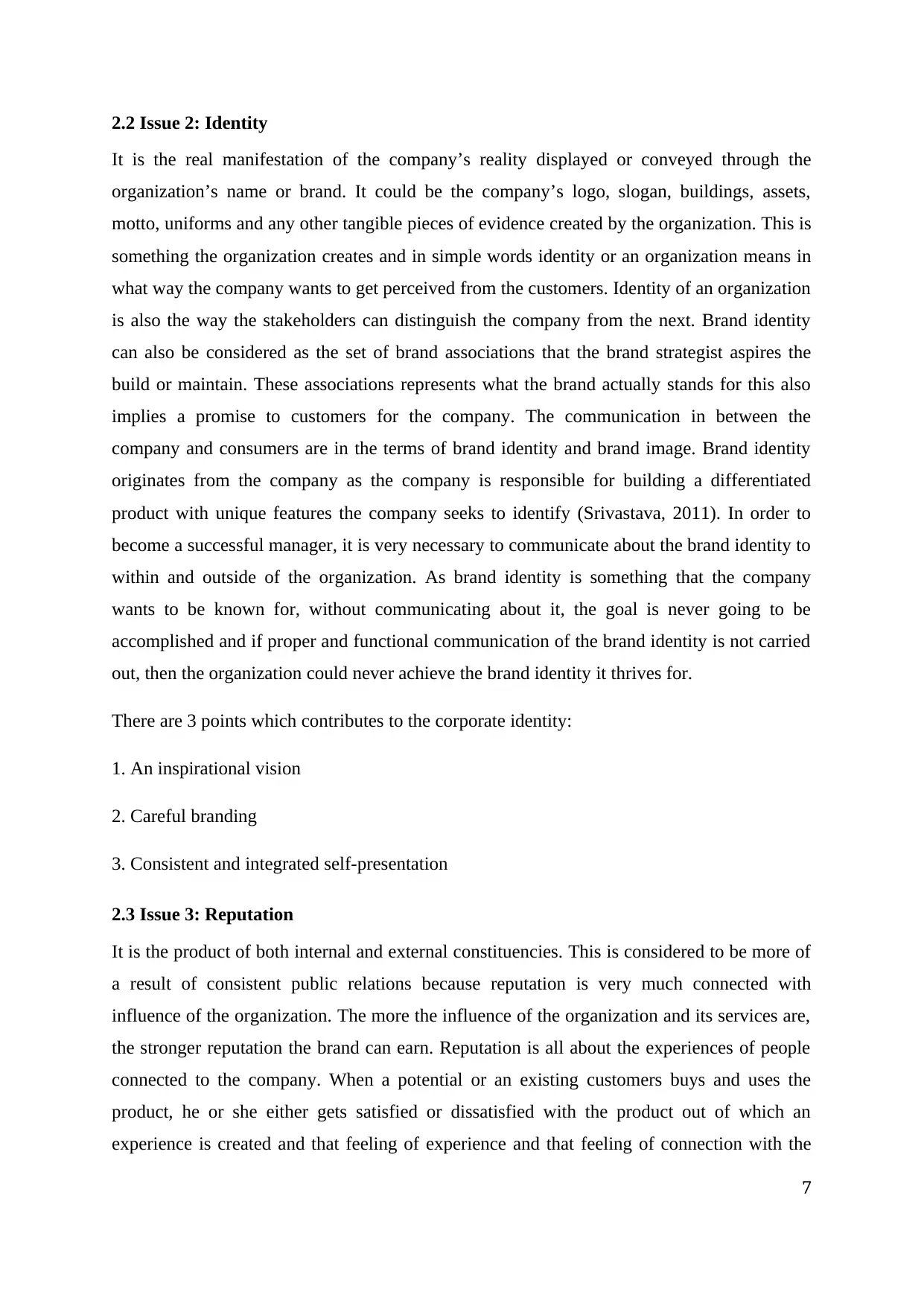
2.2 Issue 2: Identity
It is the real manifestation of the company’s reality displayed or conveyed through the
organization’s name or brand. It could be the company’s logo, slogan, buildings, assets,
motto, uniforms and any other tangible pieces of evidence created by the organization. This is
something the organization creates and in simple words identity or an organization means in
what way the company wants to get perceived from the customers. Identity of an organization
is also the way the stakeholders can distinguish the company from the next. Brand identity
can also be considered as the set of brand associations that the brand strategist aspires the
build or maintain. These associations represents what the brand actually stands for this also
implies a promise to customers for the company. The communication in between the
company and consumers are in the terms of brand identity and brand image. Brand identity
originates from the company as the company is responsible for building a differentiated
product with unique features the company seeks to identify (Srivastava, 2011). In order to
become a successful manager, it is very necessary to communicate about the brand identity to
within and outside of the organization. As brand identity is something that the company
wants to be known for, without communicating about it, the goal is never going to be
accomplished and if proper and functional communication of the brand identity is not carried
out, then the organization could never achieve the brand identity it thrives for.
There are 3 points which contributes to the corporate identity:
1. An inspirational vision
2. Careful branding
3. Consistent and integrated self-presentation
2.3 Issue 3: Reputation
It is the product of both internal and external constituencies. This is considered to be more of
a result of consistent public relations because reputation is very much connected with
influence of the organization. The more the influence of the organization and its services are,
the stronger reputation the brand can earn. Reputation is all about the experiences of people
connected to the company. When a potential or an existing customers buys and uses the
product, he or she either gets satisfied or dissatisfied with the product out of which an
experience is created and that feeling of experience and that feeling of connection with the
7
It is the real manifestation of the company’s reality displayed or conveyed through the
organization’s name or brand. It could be the company’s logo, slogan, buildings, assets,
motto, uniforms and any other tangible pieces of evidence created by the organization. This is
something the organization creates and in simple words identity or an organization means in
what way the company wants to get perceived from the customers. Identity of an organization
is also the way the stakeholders can distinguish the company from the next. Brand identity
can also be considered as the set of brand associations that the brand strategist aspires the
build or maintain. These associations represents what the brand actually stands for this also
implies a promise to customers for the company. The communication in between the
company and consumers are in the terms of brand identity and brand image. Brand identity
originates from the company as the company is responsible for building a differentiated
product with unique features the company seeks to identify (Srivastava, 2011). In order to
become a successful manager, it is very necessary to communicate about the brand identity to
within and outside of the organization. As brand identity is something that the company
wants to be known for, without communicating about it, the goal is never going to be
accomplished and if proper and functional communication of the brand identity is not carried
out, then the organization could never achieve the brand identity it thrives for.
There are 3 points which contributes to the corporate identity:
1. An inspirational vision
2. Careful branding
3. Consistent and integrated self-presentation
2.3 Issue 3: Reputation
It is the product of both internal and external constituencies. This is considered to be more of
a result of consistent public relations because reputation is very much connected with
influence of the organization. The more the influence of the organization and its services are,
the stronger reputation the brand can earn. Reputation is all about the experiences of people
connected to the company. When a potential or an existing customers buys and uses the
product, he or she either gets satisfied or dissatisfied with the product out of which an
experience is created and that feeling of experience and that feeling of connection with the
7
⊘ This is a preview!⊘
Do you want full access?
Subscribe today to unlock all pages.

Trusted by 1+ million students worldwide
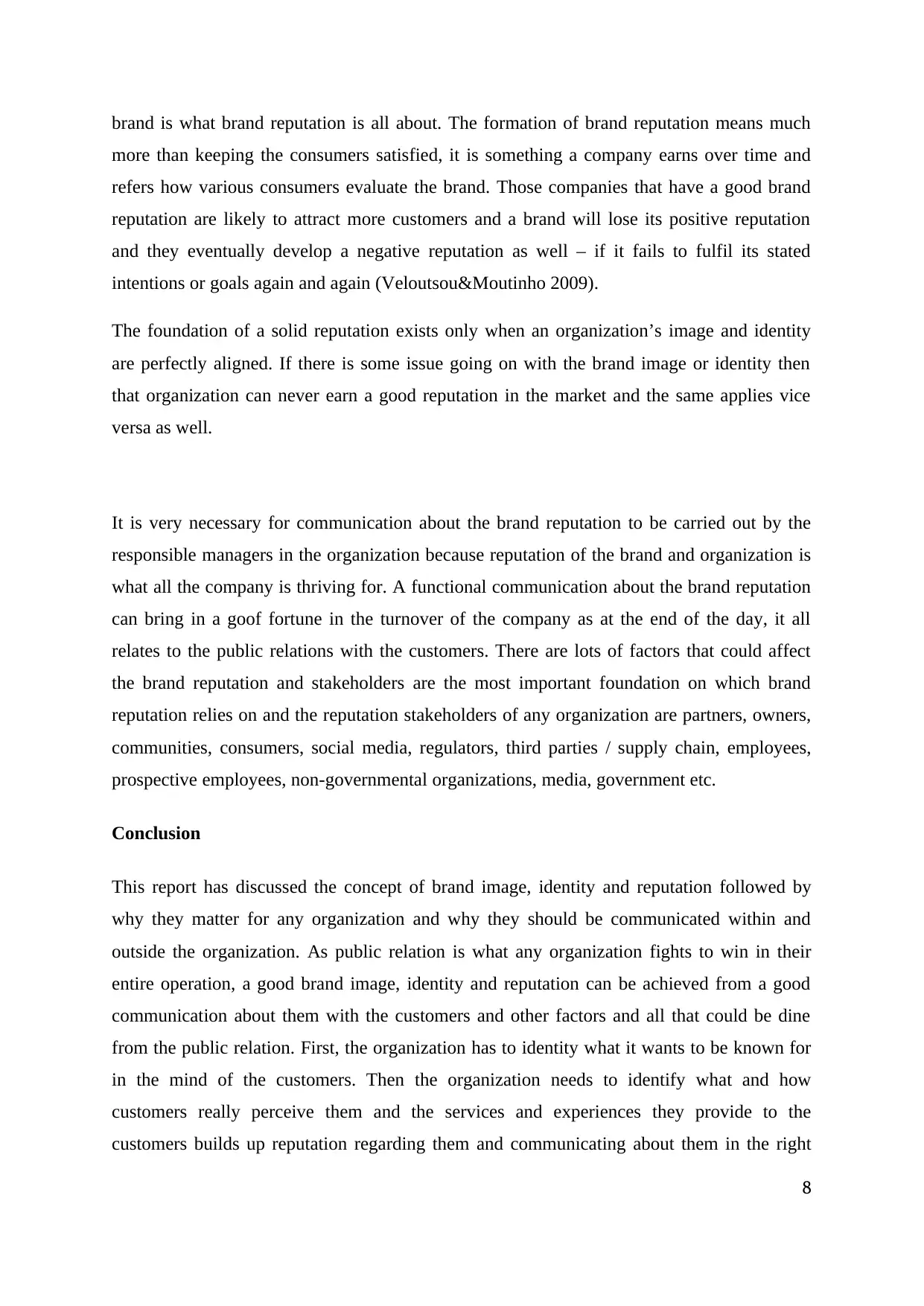
brand is what brand reputation is all about. The formation of brand reputation means much
more than keeping the consumers satisfied, it is something a company earns over time and
refers how various consumers evaluate the brand. Those companies that have a good brand
reputation are likely to attract more customers and a brand will lose its positive reputation
and they eventually develop a negative reputation as well – if it fails to fulfil its stated
intentions or goals again and again (Veloutsou&Moutinho 2009).
The foundation of a solid reputation exists only when an organization’s image and identity
are perfectly aligned. If there is some issue going on with the brand image or identity then
that organization can never earn a good reputation in the market and the same applies vice
versa as well.
It is very necessary for communication about the brand reputation to be carried out by the
responsible managers in the organization because reputation of the brand and organization is
what all the company is thriving for. A functional communication about the brand reputation
can bring in a goof fortune in the turnover of the company as at the end of the day, it all
relates to the public relations with the customers. There are lots of factors that could affect
the brand reputation and stakeholders are the most important foundation on which brand
reputation relies on and the reputation stakeholders of any organization are partners, owners,
communities, consumers, social media, regulators, third parties / supply chain, employees,
prospective employees, non-governmental organizations, media, government etc.
Conclusion
This report has discussed the concept of brand image, identity and reputation followed by
why they matter for any organization and why they should be communicated within and
outside the organization. As public relation is what any organization fights to win in their
entire operation, a good brand image, identity and reputation can be achieved from a good
communication about them with the customers and other factors and all that could be dine
from the public relation. First, the organization has to identity what it wants to be known for
in the mind of the customers. Then the organization needs to identify what and how
customers really perceive them and the services and experiences they provide to the
customers builds up reputation regarding them and communicating about them in the right
8
more than keeping the consumers satisfied, it is something a company earns over time and
refers how various consumers evaluate the brand. Those companies that have a good brand
reputation are likely to attract more customers and a brand will lose its positive reputation
and they eventually develop a negative reputation as well – if it fails to fulfil its stated
intentions or goals again and again (Veloutsou&Moutinho 2009).
The foundation of a solid reputation exists only when an organization’s image and identity
are perfectly aligned. If there is some issue going on with the brand image or identity then
that organization can never earn a good reputation in the market and the same applies vice
versa as well.
It is very necessary for communication about the brand reputation to be carried out by the
responsible managers in the organization because reputation of the brand and organization is
what all the company is thriving for. A functional communication about the brand reputation
can bring in a goof fortune in the turnover of the company as at the end of the day, it all
relates to the public relations with the customers. There are lots of factors that could affect
the brand reputation and stakeholders are the most important foundation on which brand
reputation relies on and the reputation stakeholders of any organization are partners, owners,
communities, consumers, social media, regulators, third parties / supply chain, employees,
prospective employees, non-governmental organizations, media, government etc.
Conclusion
This report has discussed the concept of brand image, identity and reputation followed by
why they matter for any organization and why they should be communicated within and
outside the organization. As public relation is what any organization fights to win in their
entire operation, a good brand image, identity and reputation can be achieved from a good
communication about them with the customers and other factors and all that could be dine
from the public relation. First, the organization has to identity what it wants to be known for
in the mind of the customers. Then the organization needs to identify what and how
customers really perceive them and the services and experiences they provide to the
customers builds up reputation regarding them and communicating about them in the right
8
Paraphrase This Document
Need a fresh take? Get an instant paraphrase of this document with our AI Paraphraser
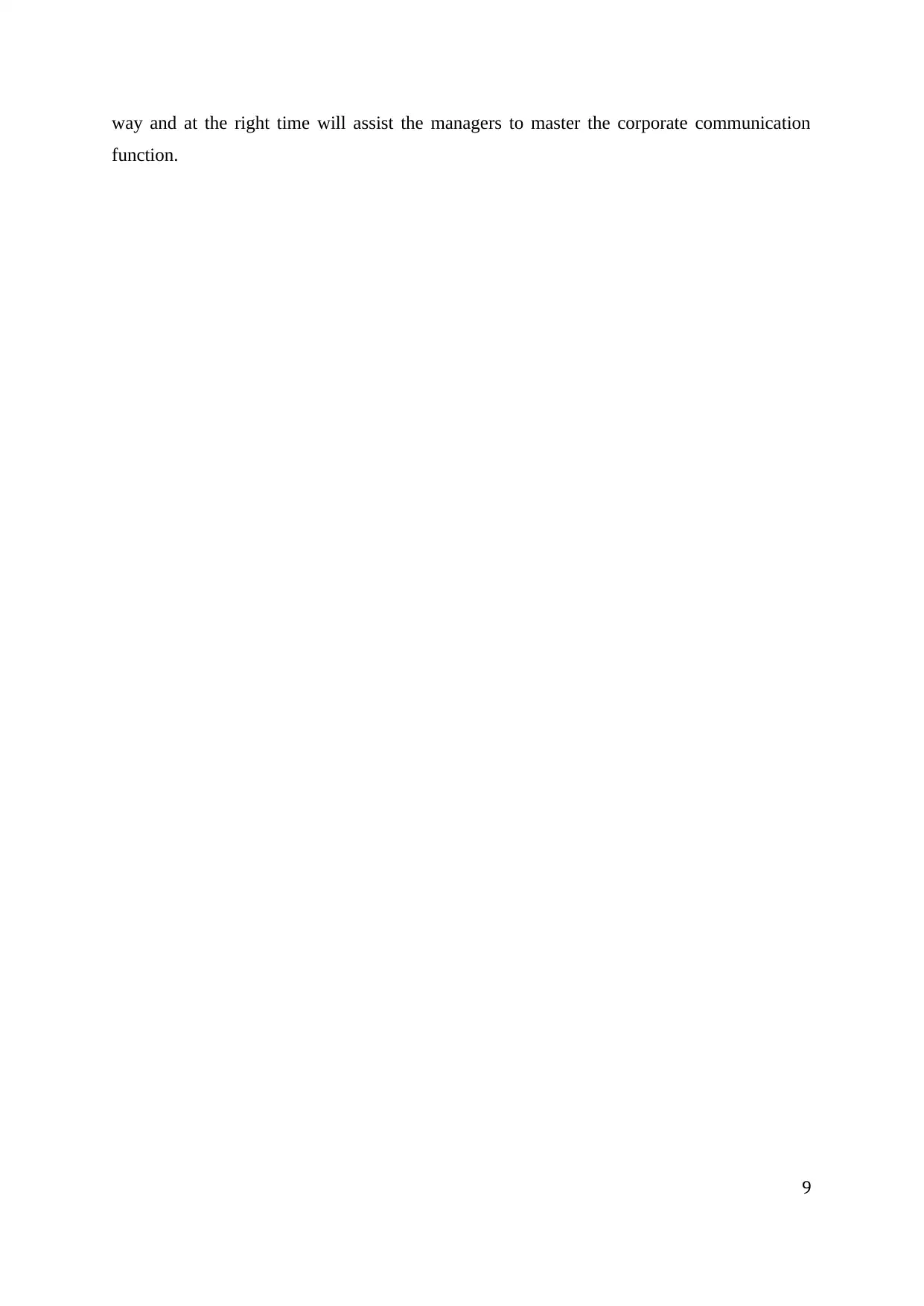
way and at the right time will assist the managers to master the corporate communication
function.
9
function.
9
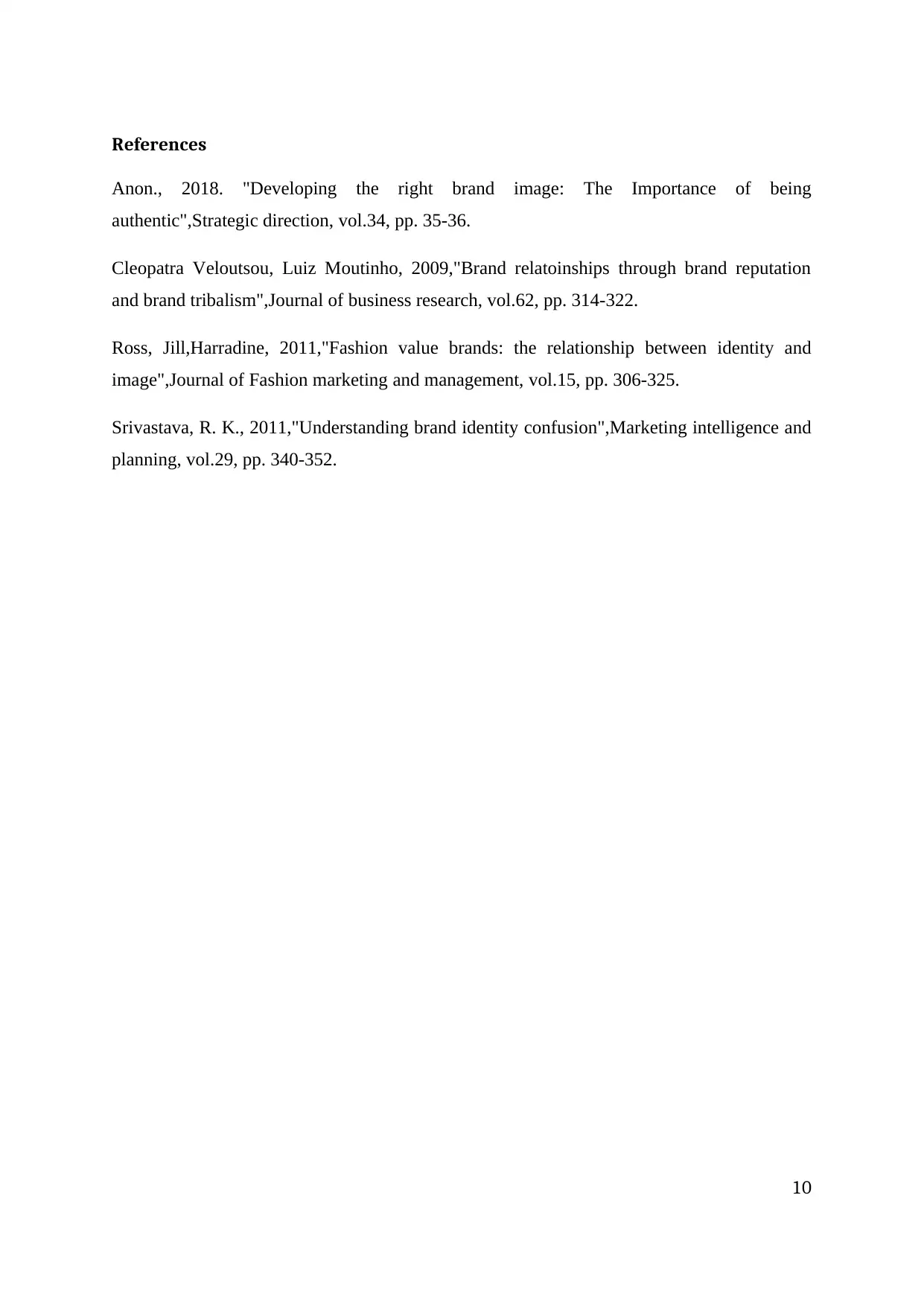
References
Anon., 2018. "Developing the right brand image: The Importance of being
authentic",Strategic direction, vol.34, pp. 35-36.
Cleopatra Veloutsou, Luiz Moutinho, 2009,"Brand relatoinships through brand reputation
and brand tribalism",Journal of business research, vol.62, pp. 314-322.
Ross, Jill,Harradine, 2011,"Fashion value brands: the relationship between identity and
image",Journal of Fashion marketing and management, vol.15, pp. 306-325.
Srivastava, R. K., 2011,"Understanding brand identity confusion",Marketing intelligence and
planning, vol.29, pp. 340-352.
10
Anon., 2018. "Developing the right brand image: The Importance of being
authentic",Strategic direction, vol.34, pp. 35-36.
Cleopatra Veloutsou, Luiz Moutinho, 2009,"Brand relatoinships through brand reputation
and brand tribalism",Journal of business research, vol.62, pp. 314-322.
Ross, Jill,Harradine, 2011,"Fashion value brands: the relationship between identity and
image",Journal of Fashion marketing and management, vol.15, pp. 306-325.
Srivastava, R. K., 2011,"Understanding brand identity confusion",Marketing intelligence and
planning, vol.29, pp. 340-352.
10
⊘ This is a preview!⊘
Do you want full access?
Subscribe today to unlock all pages.

Trusted by 1+ million students worldwide
1 out of 32
Related Documents
Your All-in-One AI-Powered Toolkit for Academic Success.
+13062052269
info@desklib.com
Available 24*7 on WhatsApp / Email
![[object Object]](/_next/static/media/star-bottom.7253800d.svg)
Unlock your academic potential
Copyright © 2020–2025 A2Z Services. All Rights Reserved. Developed and managed by ZUCOL.


